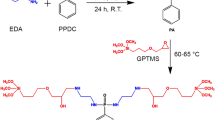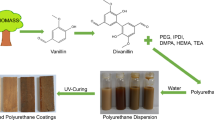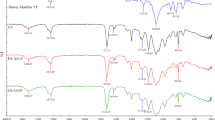Summaries
The UV-curable powder coatings allow the finishing of temperature-sensitive substrates such as wood, MDF (medium-density fibreboard), plastics and paper. The binder system is mostly comprised of unsaturated polyester, a vinyl ether and acrylic polyurethane. The curing mechanism consists of free radical polymerisation of the double bonds.
In comparison with free radical UV curing, the cationic-initiated UV-curing technology offers the advantages of insensitivity to oxygen and lower film shrinkage. Epoxides are one of the most important and widely used classes of resins in the field of cationic UV-curable powder coatings. Epoxy systems do not require any additional curing agent, they cure within seconds and have unlimited working times.
For photocationic curable powder coatings, solid epoxy resins have been used. However, such a system has some disadvantages: the epoxy value is too low to obtain sufficient cross-link density. This problem may be overcome by the use of a binder having more epoxide rings in the oligomer structure (eg epoxypolyesters). In the present study, a series of solid epoxypolyesters were prepared by polycondensation of glycols, tetrahydrophthalic anhydride and dicyclopentadiene, followed by the epoxidation of the double bonds in unsaturated polyester. The epoxypolyesters were subject to photoinitiated cationic polymerisation. The evaluation of the film performance was also carried out. The coatings prepared from these epoxypolyesters exhibited good hardness, impact strength and adhesion.
Résumé
Les revêtements UV en poudre facilitent la finition des substrats qui sont sensibles aux températures élevées, tels que les substrats de bois, de MDF (de fibres de densité moyenne) de plastiques et de papier. Le système de liants est composé pour la plus grande partie de polyesters non saturés, un éther vinylique et un polyuréthane. Le mécanisme de séchage consiste en la polymérisation de doubles liaisons par radicaux libres.
Par rapport au séchage UV à radicaux libres, la technologie du séchage UV à initiation cationique offre les avantages de l’insensibilité à l’oxygène et d’un moindre rétrécissement du film. Les époxydes sont parmi les types de résine les plus importants et les plus utilisés dans le domaine des revétements en poudre UV cationiques. Les systèmes époxy ne requièrent pas d’agent de séchage additionnel, ils sèchent en quelques secondes et offrent un temps de travail illimité. On a utilisé des résines époxy à l’état solide comme revêtements en poudre à séchange photo cationique. Cependant ce système a des inconvénients: la valeur de l’époxy est trop basse pour donner une densité suffisante de réticulation. Ce problème peut être éliminé par l’usage d’un liant qui ait plus d’anneaux époxydes dans la structure oligomère (comme, par exemple les époxy-polyesters). Au cours de cette étude on a préparé une série d’éxpoxy-polyesters par la polycondensation des glycols, tétrahydrophthalique anhydride et dicyclopentadiene, suivi de l’époxydation des doubles liaisons dans le polyester non saturé. Les époxy-polyesters ont subis une polymérisation à initiation cationique. On a aussi fait une évaluation de la performance du film. Les revétements préparés à partir de ces époxypolyesters ont fait preuve d’une bonne dureté, un bon résistance au choc et une bonne adhérence.
Similar content being viewed by others
References
Kloosterboer J G,Adv Polym Sci,84, 1, 1988
Roffey C G,Photopolymerization of Surface Coatings, Wiley, New York, ISBN 0 4711 1063 8, 1981
Pappas S P,Radiation Curing: Science and Technology, 109–15, Plenum Press, New York, ISBN 0 3064 3999 9, 1992
Crivello J V,Adv Polym Sci,62, 1, 1984
Lapin S P, ‘Radiation curring of polymeric materials’, (ed) CE Hoyle and J F Kinstle, ACS Symposium Series,363, 417, American Chemical Society, Washington DC, ISBN 0 8412 1730 0, 1989
Reiser A,Photoreactive Polymers, 95–115, Wiley, New York, ISBN 0 4718 5550 2, 1989
Griese Ch and B Carlson, ‘Development in UV-curable powder coatings’, Technical Conference Proceedings, Radtech 2000, 658–68, 9th to 12th April 2000
Wicks Z W, E N Jones and S P Pappas,Organic Coatings, Science and Technology,1, 140–50, Chapter III, Wiley, New York, ISBN 0 4716 1406 8, 1992
Decker C, ‘UV curing chemistry: Past, present and future’,J Coat Tech,59, 97, 1997;
Thames S F, J W Rawlins, ‘A review of ultraviolet-curable powder coatings’,Powder Coating,10, 19, 1996
Lohse F and H Zweifel, ‘Photocrosslinking of Epoxy Resins’,Adv Polym Sci,78, 268, 1986
Crivello JV and K Dietliker ‘Photoinitiators for cationic polymerization’,Chemistry and Technology of UV & EB Formulation for Coating, Inks and Paints,3, Chapter II, 327–478, SITA Technology Ltd, London, ISBN 0 4719 8235 0, 1999
Wicks Z W, E N Jones and S P Pappas,Organic Coatings, Science and Technology,2, 115–25, Wiley, New York, ISBN 0 4715 9893 3, 1994
Wu S, M T Sears and M D Soucek, ‘Synthesis of reactive diluent cationic cycloaliphatic epoxide UV coatings’,Polymer,40, 5675, 1999
Author information
Authors and Affiliations
Corresponding author
Rights and permissions
About this article
Cite this article
Boncza-Tomaszewski, Z., Penczek, P. & Bankowska, A. Photocationic-curable powder coatings. Surface Coatings International Part B: Coatings Transactions 89, 157–161 (2006). https://doi.org/10.1007/BF02699645
Published:
Issue Date:
DOI: https://doi.org/10.1007/BF02699645




